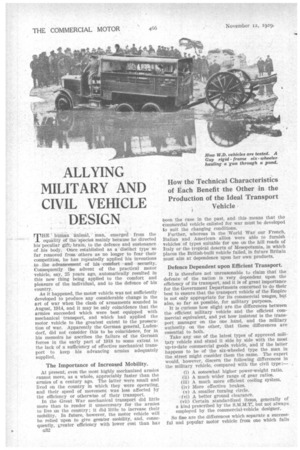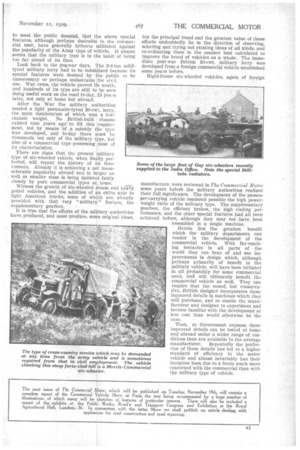ALLYING MILITARY AND CIVIL VEHICLE DESIGN
Page 138

Page 139

If you've noticed an error in this article please click here to report it so we can fix it.
T"human animal, man, emerged from the equality, of the 'specie§ mainly because he directed his peculiar gift; brain, to the defence and sustenance of his body. Once established as a distinct type so far removed from others as no longer to fear their competition, he has repeatedly applied his inventions to the advancement of his comfort and security. Consequently the advent of the practical motor vehicle, say, 25 years ago, automatically resulted in this new thing being applied to the comfort and pleasure of the individual, and to the defence of his country.
As it happened, the motor vehicle was not sufficiently developed to produce any considerable change in the art of war when the clash of armaments sounded in August, 1914, and it may be only coincidence that the armies succeeded which were best equipped with mechanical transport, and which had applied the motor vehicle to the greatest extent to the prosecution of war. Apparently the German general, Ludendorf, did not consider this to be coincidence, for in his memoirs he ascribes the failure of the German forces in the early part of 1918 to some extent to the lack of a sufficiency of effective mechanical transport to keep his advancing armies adequately supplied.
The Importance of Increased Mobility.
At present, even the most highly mechanized armies cannot move, as a whole, appreciably faster than the armies of a century ago. The latter were small and lived on the country in which they were operating, and their speed of movement was less affected by the efficiency or otherwise of their transport. '
In the Great War mechanical transport did little more than to render it unnecessary for the armies to live on the country ; it did little to increase their mobility. In future, however, the motor vehicle will be relied upon to give greater mobility, and, consequently, greater efficiency with lower cost than has Q32 been the case in the past, and this means that the commercial vehicle enlisted for war must be developed to suit the changing conditions.
Further, whereas in the World War our French, Italian and American allies were able to furnish vehicles of types suitable for use on the hill roads of Italy or the tropical deserts of Mesopotamia, in which places the British-built vehicle failed, in future Britain must aim at dependence upon her own products.
Defence Dependent upon Efficient Transport.
It is therefore not unreasonable to claim that the defence of the nation is very dependent upon the efficiency of its transport, and it is of great importance for the Government Departments concerned to do their best to ensure that the transport vehicle of the Empire is not only appropriate for its commercial usages, but also, so far as possible, for military purposes.
It is curious how slight are the differences between the efficient military vehicle and the efficient commercial equivalent, and yet how insistent is the transport manager on the one hand, and the military authority on the other, that these differences are essential to both.
Take any one of the latest types of approved military vehicle and stand it side by side with the most up-to-date commercial goods vehicle, and if the latter happens to be of the six-wheeled type the man in the street might consider them the same. The expert would, however, discern the following differences in the military vehicle, compared with the civil type:— (i) A somewhat higher power-weight ratio.
(ii) A much wider range of gear ratios.
(iii) A much more efficient cooling system.
(iv) More effective brakes.
(v) A smaller turning circle, (v1) A better ground clearance. (vii) Certain standardized items, generally of a kind prescribed by the S.M.M.T, but not always employed by the commercial-vehicle designer.
So fine are the differences which separate a successful and popular motor vehicle from one which fails to meet the public demand, that the above special features, although perhaps desirable to the commercial user, have generally hitherto militated against the popularity of the Army type of vehicle. It almost seems that the military type is in the habit of being too far ahead of its time.
Look back to the pre-war days. The 3-4-ton solidtyred military lorry had to be. subsidized because its special features were deemed by the public to be unnecessary orperhaps undesirable for civil use. War came, the vehicle proved its worth, and hundreds of its type are still to be seen doing useful work on the road to-day, 15 years later, not only at home but abroad.
After the War the military authorities needed a light pneumatic-tyred 30-cwt. lorry, the main desideratum of which was a low • chassis weight. No British-built chassis • existed nine years ago to fill this requirement, but by means of a subsidy the type was developed, and to-day there must be thousands, not only of the military type, but also of a commercial type possessing most of its characteristics. .
There are signs that the present military type of six-wheeled vehicle, when finally perfected, will repeat the history of its forerunners. Already it is achieving a not inconsiderable popularity abroad and in larger as well, as smaller sizes is being imitated fairly closely by pure commercial types at home.
Witness the growth of six-wheeled steam and heavy petrol vehicles, and the addition of an extra axle to light American trucks, some of which are already provided with that very "military" feature, the supplementary gearbox.
It is true that the efforts of the military authorities have, produced, and must produce, some original ideas, , but the principal trend and the greatest value of these efforts undoubtedly lie in the direction of observing, • selecting and trying out existing ideas of all kinds, and co-ordinating them in the manner best calculated to improve the breed of vehicles as a whole. The immediate post-war British 30-cwt. military lorry was developed from a foreign commercial vehicle established some years before.
Rigid-frame six-wheeled vehicles, again of foreign
manufacture, were reviewed in The Commercial Motor some years beforre the military authorities realized their full significance. The development of the passenger-carrying vehicle rendered possible the high powerweight ratio of the military type. The supplementary gearbox, the efficient brakes, the high cooling performance, and the other special features had all beeii achieved before, although they may not have been
assembled in a single machine.
Herein lies the' greatest benefit which -the• military departments can render in the development of the commercial vehicle. With far-reaching tentacles in all parts of the world they can hear of and See improvements in design which, although perhaps primarily of benefit to the military vehicle, will have beeninitiated in all probability for some commercial need, and will ultimately benefit the commercial vehicle as well. They, can require that the sound, but. conservative, British designer incorporates these improved details in machines which they will -purchase, and so enable the manufacturer arid designer to experiment and become familiar with the development at less cost than would otherwise be the case.
Then, at Government expense these improved details can be tested at home and abroad under a wider,range of conditions than are available to the average manufacturer. Repeatedly the perfection of these details has led to a higher standard of efficiency in the motor vehicle and almost invariably has their inception been due to a brain much more concerned with the commercial than with the military type. of vehicle.








































































































































































































































































































































